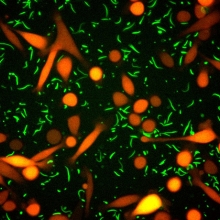Major leaps forward in stem cell research
Dr. Jacob Hanna
Briefs

One of the obstacles to employing human embryonic stem cells for medical use—like replacing diseased tissue with healthy tissue—lies in their very promise: They are born to rapidly differentiate into other cell types. Until now, scientists have not been able to efficiently keep embryonic stem cells in their pristine stem state.
The alternative that has been proposed to embryonic stem cells are reprogrammed adult cells called induced pluripotent stem cells (iPS cells). However, they have similar limitations. Though iPS cells can differentiate into many different cell types, they retain signs of “priming” – commitment to specific cell lineages. This fall, however, a team of Weizmann Institute scientists led by Dr. Jacob Hanna from the Department of Molecular Genetics published key findings showing that they have taken a large step toward removing that obstacle: They have created iPS cells that are completely “reset” to the earliest possible state and maintained them in that state.
Dr. Hanna and his team, as well as researchers at the Nancy and Stephen Grand Israel National Center for Personalized Medicine at the Weizmann Institute, realized that inserting genes to reset the stem cells was not enough. One also has to put the cells’ innate drive to differentiate essentially on hold. Dr. Hanna and his group realized that if they could understand how the mouse embryonic stem cells manage to refrain from differentiating in the lab, they could apply it to the human versions. Through lab experiments and genetic analysis, they worked out a “treatment” for the iPS cells in the lab dish to damp down the genetic pathway for differentiation.
Dr. Hanna says, “These cells correspond to the earliest stages of human embryonic stem cells that have been isolated. We managed to freeze what is essentially a very fleeting situation and to produce a new, unprimed, pluripotent state in stem cells.” These findings may have many uses in biomedical research, specifically in gene therapy research, as well as genetic engineering.
Another obstacle in the manipulation of the production of stem cells is that the process has remained frustratingly slow and inefficient. iPSCs are created by inserting four genes into the DNA of the adult cells, however, the reprograming process is fraught with difficulty: It can take up to four weeks; the timing is not coordinated among the cells; and less than one percent of the treated cells actually end up becoming stem cells. But Dr. Hanna’s lab has made major strides on that front as well. In findings recently described in Nature, he and his group revealed the “brake” that holds back the production of stem cells - a protein called MBD3 - and found that releasing this brake (removing it) can both synchronize the process and increase its efficiency - from around 1 percent or less to, amazingly, 100 percent.
Meanwhile, the time needed to produce the embryonic stem cells was shortened from four weeks to eight days. As an added bonus, since the cells all underwent the reprograming at the same rate, the scientists will now be able, for the first time, to better follow it, step by step, and reveal its mechanisms of operation.
Dr. Hanna is supported by Pascal and Ilana Mantoux, France/Israel, The Benoziyo Endowment Fund for the Advancement of Science, the Leona M. and Harry B. Helmsley Charitable Trust, The Sir Charles Clore Research Prize, Erica A. Drake and Robert Drake, the European Research Council, and the Fritz Thyssen Stiftung.








